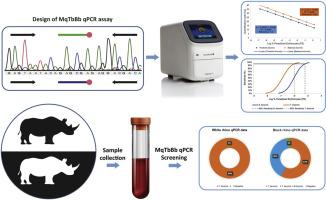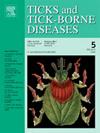Advancing disease surveillance in rhinoceroses: A multiplex real-time PCR assay for detecting Theileria bicornis and Babesia bicornis
IF 3.4
2区 医学
Q2 INFECTIOUS DISEASES
引用次数: 0
Abstract
Black (Diceros bicornis) and white (Ceratotherium simum) rhinoceroses in Southern Africa face multiple threats, including poaching, habitat loss, and translocation stress. Infections with Theileria bicornis (in both rhino species) and Babesia bicornis (confirmed only in black rhinos) add further health risks, with stressors such as translocation potentially increasing susceptibility. Effective management requires sensitive molecular diagnostic assays for accurate detection and surveillance. To address this, we developed a multiplex qPCR assay (MqTbBb) using species-specific TaqMan™ minor groove binder (MGB) probes for the simultaneous detection of T. bicornis and B. bicornis. The assay targets 18S rRNA gene regions, amplifying an 87 bp fragment for T. bicornis and a 51 bp fragment for B. bicornis, with efficiencies of 100 % and 98 %, respectively. Probit analysis determined a 95 % Limit of detection of 1.00 × 10⁻⁶ % and 6.27 × 10⁻⁶ % equivalent parasitized erythrocytes for T. bicornis and B. bicornis, respectively. No cross-reactivity was observed with other related protozoa tested. A total of 223 field samples from rhinos (101 black and 122 white) in Mpumalanga province were screened using both the MqTbBb and Reverse Line Blot (RLB) hybridization assays. The MqTbBb detected T. bicornis in 57 % of black and 99 % of white rhinos, with co-infections in 40 % of black rhinos. RLB detected T. bicornis in 96 % of black and 95 % of white rhinos, with a Babesia catch-all probe signal in 75 % and 32 %, respectively. B. bicornis was not detected by RLB and was never detected as a single infection by qPCR. These findings highlight high T. bicornis prevalence and rare B. bicornis infections (co-infections). The MqTbBb assay strengthens detection, surveillance, and conservation efforts.

推进犀牛疾病监测:双角勒氏菌和巴贝斯虫多重实时PCR检测
非洲南部的黑犀牛(Diceros bicornis)和白犀牛(Ceratotherium simum)面临多种威胁,包括偷猎、栖息地丧失和迁移压力。双角梭菌(在两种犀牛中)和巴贝斯虫(仅在黑犀牛中得到证实)的感染进一步增加了健康风险,易位等压力因素可能会增加易感性。有效的管理需要灵敏的分子诊断分析来准确检测和监测。为了解决这个问题,我们开发了一种多重qPCR检测(MqTbBb),使用物种特异性TaqMan™次要凹槽结合物(MGB)探针同时检测双角锥虫和双角锥虫。该方法以18S rRNA基因区域为靶点,分别扩增了双角天牛的87 bp和51 bp片段,扩增效率分别为100%和98%。概率分析确定了双角锥虫和双角锥虫寄生红细胞的检出限分别为1.00 × 10⁻26 %和6.27 × 10⁻26 %。与所测其他相关原生动物无交叉反应。采用MqTbBb和RLB杂交技术对普马兰加省223份野外犀牛样本(101头黑犀牛和122头白犀牛)进行了筛选。MqTbBb在57%的黑犀牛和99%的白犀牛中检测到双角锥虫,在40%的黑犀牛中检测到双角锥虫。RLB在96%的黑犀牛和95%的白犀牛中检测到双角锥虫,巴贝斯虫捕获信号分别为75%和32%。RLB未检测到双角锥虫,qPCR未检测到单一感染。这些发现突出了双角锥虫的高患病率和罕见的双角锥虫感染(合并感染)。MqTbBb检测加强了检测、监测和保护工作。
本文章由计算机程序翻译,如有差异,请以英文原文为准。
求助全文
约1分钟内获得全文
求助全文
来源期刊

Ticks and Tick-borne Diseases
INFECTIOUS DISEASES-MICROBIOLOGY
CiteScore
6.90
自引率
12.50%
发文量
185
审稿时长
6-12 weeks
期刊介绍:
Ticks and Tick-borne Diseases is an international, peer-reviewed scientific journal. It publishes original research papers, short communications, state-of-the-art mini-reviews, letters to the editor, clinical-case studies, announcements of pertinent international meetings, and editorials.
The journal covers a broad spectrum and brings together various disciplines, for example, zoology, microbiology, molecular biology, genetics, mathematical modelling, veterinary and human medicine. Multidisciplinary approaches and the use of conventional and novel methods/methodologies (in the field and in the laboratory) are crucial for deeper understanding of the natural processes and human behaviour/activities that result in human or animal diseases and in economic effects of ticks and tick-borne pathogens. Such understanding is essential for management of tick populations and tick-borne diseases in an effective and environmentally acceptable manner.
 求助内容:
求助内容: 应助结果提醒方式:
应助结果提醒方式:


